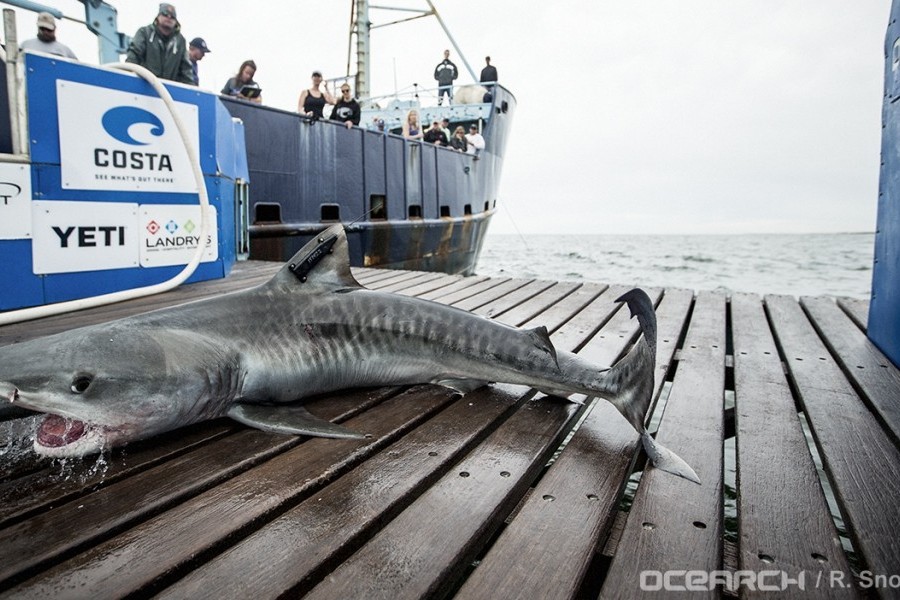Mote scientists return from major shark research expedition aboard M/V OCEARCH
Three Mote Marine Laboratory scientists have returned to Sarasota from a three-week shark research expedition aboard the internationally known M/V OCEARCH.
Expedition Jacksonville launched March 15 and returned April 2. It started from Jacksonville, Florida, proceeded off Florida's northeastern coast, and for the first time in an OCEARCH shark expedition, reached waters off the southern coast of Georgia.
The goal of the expedition was to generate scientific data critical to ocean conservation by satellite tagging sharks off Northeast Florida and Southeast Georgia to study their health and behavior.
During the expedition, 11 scientists from 10 institutions caught, sampled and released seven sharks with a purpose of gathering data to further understand the ecology, natural history, physiology and behavior of large sharks in the Atlantic Ocean.
Four tiger sharks were fitted with SPOT tags (a type of satellite tag that tracks the shark’s location and sends data back to scientists when the shark’s dorsal fin breaks the water’s surface), and three of those sharks were fitted with acoustic tags to help monitor their position at a finer scale. One sand tiger shark was tagged with an acoustic tag, and two blacknose sharks were not tagged, but blood samples and other tests were performed.
Below are the sharks caught and released during Expedition Jacksonville:
Georgia, an 8-foot, 5-inch female tiger shark was fitted with a SPOT and an acoustic tag
Viper, a 7-foot, 7-inch male tiger shark was fitted with a SPOT tag
A.B., a 9-foot, 8-inch male tiger shark was fitted with a SPOT and an acoustic tag
Duval, an 9-foot male tiger shark was fitted with a SPOT and an acoustic tag
A pregnant female sand tiger shark was fitted with an acoustic tag
A pregnant female blacknose shark was given an ultrasound and blood samples were taken, but no scientific tags were deployed
A non-pregnant female blacknose was given an ultrasound and blood samples were taken, but no scientific tags were deployed
The public can track Georgia, Viper, A.B. and Duval at www.ocearch.org.
Participating Mote scientists included Drs. Robert Hueter, Heather Marshall and Kim Ritchie.
Hueter served as a principal investigator on the expedition, helping to oversee the dozen or so procedures that are performed during the 15 minutes when scientists have access to sharks on the ship's lift. He focuses primarily on using satellite tags to track long-term movements of sharks for up to five years. This helps reveal what habitats and space these animals need to thrive.
“Although no white sharks were caught during this expedition, which was its original goal, the scientific data that this collaborative team collected will teach us a lot about the behaviors and habitat use of tiger sharks in the Atlantic Ocean,” Hueter said. “This is all very important information for us to work toward the conservation of this ecologically important species.”
Marshall took blood samples from all the sharks caught and released to study the physiological effects of capture stress. Because incidental fishing capture of sharks is a worldwide problem, it is critical to understand how capture and handling affects the sharks' physiology and ability to recover. Such data are vital for management of sharks vulnerable to being overfished and/or becoming accidental bycatch.
“These sharks are the balance keepers of the oceans, but very little is known about them,” Marshall said. “Having the opportunity to observe and study these sharks, to be able to take samples of their blood to learn how they react after they are caught, handled and released, is essential for learning how to better conserve these species and our marine ecosystems.”
Blood samples can also shed light on a key step in sharks' life cycle: reproduction. Two confirmed pregnancies, combined with the reproductive hormone analysis that will be performed from the blood samples Marshall took, will help researchers better understand hormone levels and the reproductive physiology of pregnant sharks.
Ritchie collected bacterial samples from the sharks' epidermis (outermost layer of skin) to study the antibiotic-producing bacteria associated with large sharks, which can help explain the animals' natural resistance to disease and injury. Ritchie's work will build upon Mote’s unique research project studying antibiotic-producing bacteria from stingrays (relatives of sharks) with the dual goals of understanding these animals' immunity and discovering novel sources of antibiotics.
From the seven sharks she sampled, Ritchie isolated 1,053 bacterial strains that will be genetically identified and screened for antibiotic activity.
“I would definitely say my first expedition aboard the OCEARCH vessel was a successful one,” Ritchie said. “But the work isn’t over. Now that we've isolated these bacteria, we need to genetically identify them and screen them for antibiotic production."
Once Ritchie and her students are able to identify a set number of unique bacterial strains, they will screen them against eight human and three marine pathogens for possible new sources of antibiotics that could fight antibiotic-resistant bacteria.
“This expedition was my first chance to get bacterial strains from sharks and I sampled three species! To my knowledge, no one has looked for antibiotic producing bacteria in sharks before,” Ritchie said.
All data from the expedition will be shared in an open source environment so collaborating institutions can ultimately publish studies in peer-reviewed scientific journals. Peer-reviewed studies, which can take two-to-five years to publish, can inform management and policy decisions about these important ocean predators.
